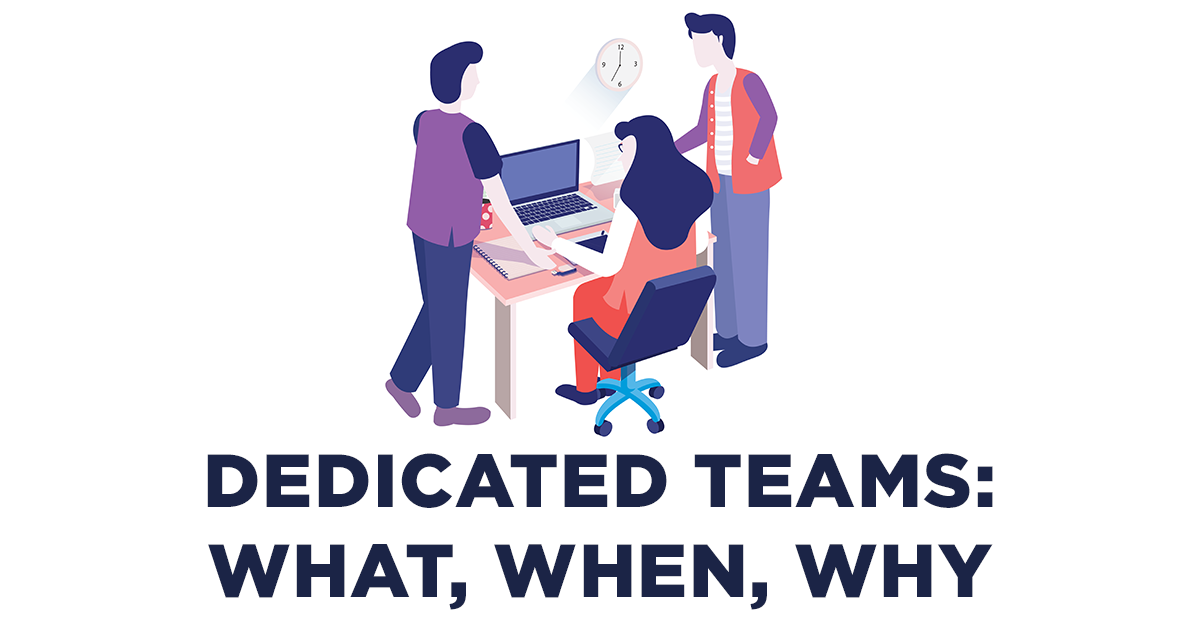All You Need to Know About Dedicated Teams

The difference between well and poorly developed software can make or break a business.
The latest surveys show that capacity is the biggest challenge for 21% of software development companies. For 16%, it is hiring talent. Finding and managing the right talent is not only tricky, but it can also be costly. One solution to these challenges is the use of a dedicated team model, also called outstaffing.
The model refers to a long-term partnership between a client and a service provider, where the latter provides software development professionals to fulfill a client’s needs. As a result, a client manages a team of specialists with skills and experience relevant to the project.
When to Rely on a Dedicated Team
The dedicated team model works just as well for start-ups as it does for established businesses. The type of project is a much more important criterion than the size of a company. The model works best when there is a big project, multiple projects, or a large number of tasks. The longer a dedicated team works with a client, the better their utilization and efficiency.
If a project’s scope, timeline, or budget might change, the dedicated team model provides much greater capacity flexibility. A client can change the size of a team to handle new tasks without sacrificing the quality of deliverables.
Another criterion to consider is the staffing needs. If a client needs to start working on a project asap, a dedicated team can be hired and selected faster than building one from the ground up, especially if a project needs to use a specific technology.
Advantages
Collaborative Environment. Overcoming project challenges together with a client on a daily basis, improves the performance of a dedicated team significantly. Given their relevant experience, specialists can generate valuable insights and bring much more value to the table when they work closely with a client. Dedicated team members that are actively involved in a project are more invested in bringing it to fruition.
Full Control. With full control over the working process and implementation status, clients have complete freedom over how they want to develop their projects. As opposed to a strictly planned out time and materials model, a client can make changes and modifications throughout the development process.
Faster Development. All people involved in a project will dedicate all of their attention and focus towards a client’s goal. No other clients and no distractions mean the team can apply their experience towards fulfilling objectives quickly. If the client needs results faster, the team can be swiftly expanded not only with more specialists but with people with the necessary expertise.
Cost-Effective. Hiring an off-site team is usually cheaper than recruiting and retaining local professionals, particularly if the team is in another country where software development costs are much lower. And it’s not just the salaries that help to keep costs down. According to estimates, the cost of hiring an in-house software engineer can reach $50k. Selecting a dedicated team from a pool of carefully vetted specialists is much quicker, cheaper, and easier than recruiting, interviewing, and hiring candidates independently.
Disadvantages
Yet, the model is not without its flaws. Short term partnerships, for one, are less efficient than longer projects because employees don’t have enough time to understand the whole picture and adapt to a client’s workflow.
Depending on the location of a client and a dedicated team, the difference across time zones can make communication difficult. However, the time difference between the U.S. and Europe works well for communication twice a day.
How to Ensure Effective Collaboration
Assigning a skilled project manager to oversee a team helps to motivate employees. As a representative of a client, the manager can identify goals and lay out requirements clearly to prevent uncertainty.
Allocating challenging engineering tasks, monitoring results, and reviewing performance can vastly improve team performance. While swapping around employee responsibilities from time to time helps to keep specialists engaged and focused.
However, rushing deliveries can result in burnouts and quick turnover within the team. Frequent changes that cancel previous work and unprofessional communication are other issues that demoralize teams and diminish their effectiveness.
Summary
The dedicated team model has proven itself to be a breakthrough in the area of outsourcing. It is an effective cooperation model that offers excellent benefits. But it is worth considering whether the model is well aligned with your business goals and project needs before hiring a team.
If you would like to find out whether the dedicated team model is right for you, don’t hesitate to contact us today.
Jazzros is a trusted provider of dedicated teams with offices in Poland and Ukraine. Our team of experts consists of Software Developers, Machine Learning Engineers, DevOps, and many more talented people.
To enable comments sign up for a Disqus account and enter your Disqus shortname in the Articulate node settings.